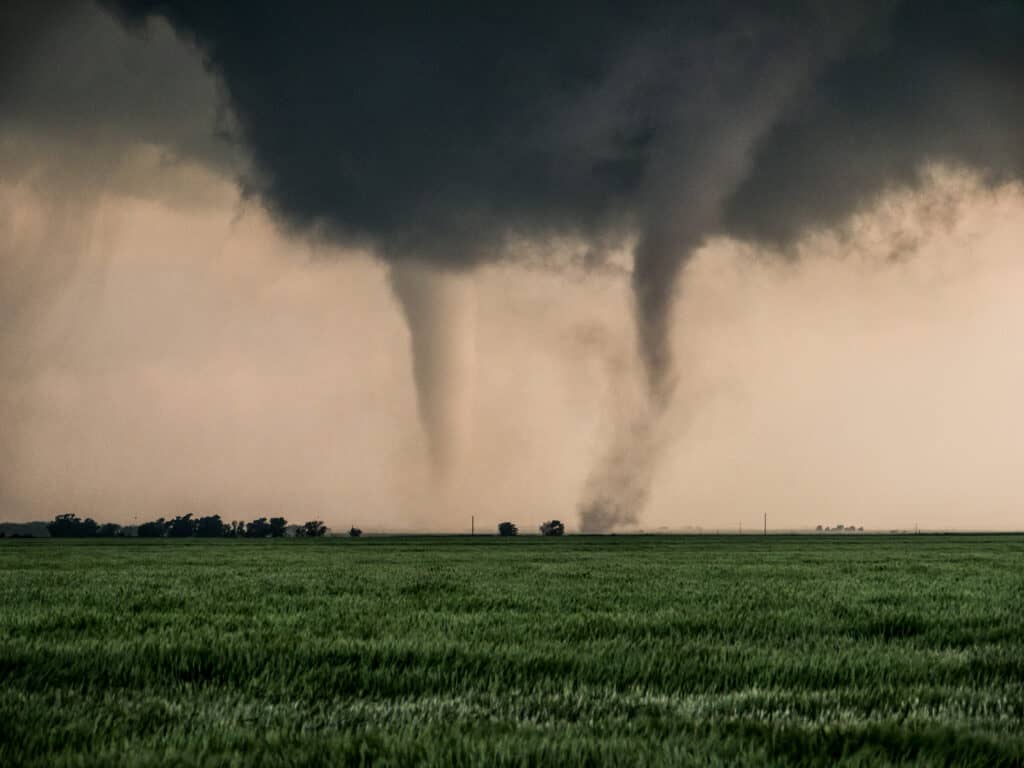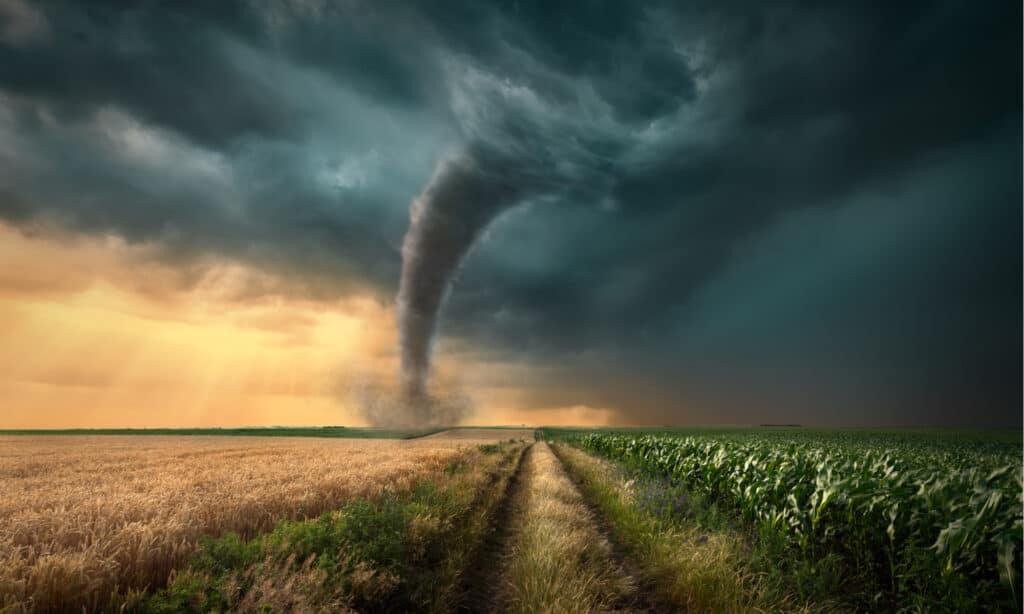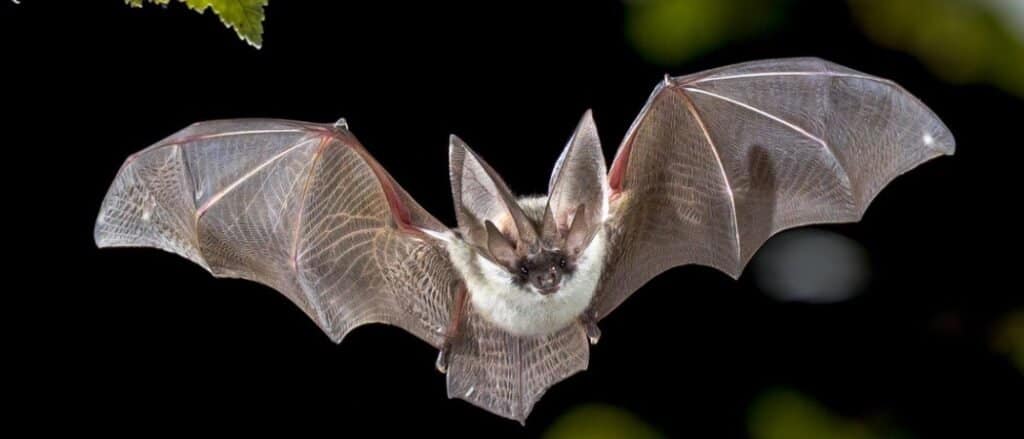Tornadoes, those swirling storms that have fascinated and terrified humanity for centuries, are a notable part of life in Indiana. Known for its picturesque landscapes, the Hoosier State also sits in a part of the country where weather conditions often conspire to create these powerful phenomena.
Across the state, towns, and cities brace for tornado season, a time when the atmospheric elements can come together in an unpredictable dance, giving rise to these storms.
But the frequency and intensity of tornadoes can vary significantly across the state. As a result, some towns might see only an occasional storm, while others have the unwanted distinction of being regular hosts to these turbulent visitors.
In this article, we discover the Indiana town most likely to be hit by a tornado.
Let’s dive right in!
The Indiana Town Most Likely to Be Hit by a Tornado

Warren Park is the Indiana town most likely to be hit by a tornado.
©Eugene R. Thieszen/Shutterstock.com
With a Tornado Index of 429.54, Warren Park is the Indiana town most likely to be hit by a tornado. But, unfortunately, it’s a place where tornadoes are more than just a weather forecast–they’re a way of life.
Warren Park, Indiana, might appear like any other small, tight-knit community nestled in the heartland of the United States, but it has an unusual claim to fame.
But fear not; Warren Park isn’t just about twisters. It’s a town brimming with charm, history, and a vibrant community spirit, despite its relationship with tornadoes.
Understanding Tornadoes
Before diving into Warren Park’s unique relationship with tornadoes, let’s take a moment to understand these incredible natural phenomena. Tornadoes are awe-inspiring, powerful, and sometimes terrifying. But what are they exactly, and how do they form? In this section, we’ll break down the basics, from their formation to how they’re rated.
What is a Tornado, and How Does it Form?
A tornado is a swiftly spinning air column stretching from the bottom of a thunderstorm cloud right down to the earth’s surface. These violent windstorms often form when warm, moist air meets cooler, drier air, creating an unstable atmosphere. As the warm air rises, it can create a spinning column of air that eventually forms a funnel cloud. When this funnel cloud touches down on the ground, we’ve got ourselves a tornado.
Tornado Ratings: EF0 to EF5
Now, not all tornadoes are created equal. To measure the intensity of these powerful windstorms, scientists use the Enhanced Fujita Scale. The scale ranges from EF0, representing relatively weak tornadoes with wind speeds of 65-85 mph, to EF5, the most intense category, with wind speeds over 200 mph. The damage caused by a tornado can be significantly different based on its rating, with EF5 tornadoes capable of leveling entire neighborhoods.
Why Are Some Areas More Prone to Tornadoes?
Certain areas are more prone to tornadoes because of a mix of geographic and weather-related conditions. For example, in the United States, the area known as “Tornado Alley“—which includes parts of Nebraska, Kansas, Oklahoma, and Texas—sees a high frequency of tornadoes.
This is because the area is characterized by a unique convergence of:
- The Rocky Mountains’ cool, dry air
- The Gulf of Mexico’s warm, moist air
- Strong winds from the jet stream
This mix of atmospheric conditions is just right for spawning tornadoes. But as we’ll see, Warren Park in Indiana has its own set of factors that make it a tornado hotspot.
Warren Park’s Tornado Index

The Index for Warren Park stands at 429.54, a number calculated based on historical tornadoes, their severity, and the chance of future storms.
©Rasica/Shutterstock.com
When it comes to understanding the tornado risk in any given area, the Tornado Index becomes a crucial tool. For Warren Park, this index offers a tangible way to measure the town’s tornado risk and compare it with other locations.
Warren Park’s Index
As mentioned earlier, the Tornado Index for Warren Park stands at 429.54. This number is calculated based on historical tornado events, their severity, and the chance of future occurrences. An index above 100 indicates a higher-than-average risk compared to the rest of the U.S., which has a baseline index of 100. Therefore, with an index of 429.54, Warren Park’s tornado risk is over four times the national average.
What Does the Index Mean?
The Tornado Index is designed to give an idea of the relative risk of tornadoes in different locations. A higher index means a higher risk. It doesn’t predict when or if a tornado will strike—it’s about the relative likelihood. So, for Warren Park, a higher index means residents need to be more prepared for the possibility of tornadoes.
Comparing with Other Cities
To put Warren Park’s Tornado Index into context, let’s look at a couple of other cities known for their high tornado risk. Moore, Oklahoma, a city that has seen some of the most devastating tornadoes in recent history, has a Tornado Index of 650.28, significantly higher than Warren Park’s.
On the other hand, Wichita, Kansas, another city in the infamous “Tornado Alley,” has a slightly lower index at 363.11.
These comparisons help to demonstrate the varying degrees of tornado risk across different regions. So while Warren Park’s Tornado Index is high, it’s not the highest—but it’s still a significant factor in the town’s planning and preparedness efforts.
How Many People Live in Warren Park
Let’s put a human face on Warren Park, the town that’s become synonymous with tornadoes in Indiana. It’s not just about the storms and the statistics; it’s about the people. So, how many folks call Warren Park home? Let’s dive into the numbers.
A Close-Knit Community
Warren Park may be small, but it’s buzzing with life. Around 1,596 people reside here, according to the latest census data. That’s 1,596 lives intertwined, 1,596 stories unfolding every day, and 1,596 reasons why this community is more than just a dot on the tornado map.
Households and Families
Dig a little deeper, and you’ll find that these 1,596 people make up about 700 households. Some are families, with around 405 families nestled within Warren Park’s boundaries. Others are individuals living solo, with about 380 residents enjoying their own space. Each household, each family, and each individual adds a unique thread to the fabric of Warren Park.
A Mix of Ages
Age is but a number, but it’s a number that tells a story. In Warren Park, the median age is 37.4 years. That’s a mix of young, old, and everyone in between. It’s children who’ve grown up with tornado drills as part of their routine, adults who’ve witnessed the strength of their community in the face of storms, and seniors who’ve seen the landscape of Warren Park change over the years.
Wildlife Around Warren Park

The night brings its share of mammals, with bats playing a crucial role in managing insect populations.
©Rudmer Zwerver/Shutterstock.com
Warren Park, despite being a small urban spot, is a vibrant oasis for an array of wildlife. It’s geographical positioning, coupled with numerous green spaces, allows it to sustain a diverse ecosystem. Let’s delve into the details of the wildlife that shares Warren Park with its human residents.
Birds
Warren Park’s skies are often graced by a variety of birds. Frequent sightings include the northern cardinal, Indiana’s iconic state bird, recognized by its fiery red feathers and cheerful song. Other residents include the American robin, blue jay, and an array of sparrows and finches. During migration periods, the town becomes a temporary refuge for many migratory birds, offering birdwatchers a delightful spectacle.
Mammals
Warren Park’s green corners host several mammalian species. The graceful white-tailed deer are often spotted wandering in the town’s more peaceful areas. Meanwhile, mischievous raccoons, opossums, and squirrels are common visitors in the local backyards. But, of course, the night brings its share of mammals too, with bats playing a crucial role in managing insect populations.
Insects and Other Small Wonders
Warren Park’s wildlife isn’t just about the creatures we can easily spot. It encompasses a rich variety of insects, from industrious bees and vibrant butterflies contributing to pollination to the magical fireflies that illuminate summer evenings. The town’s parks and gardens also host earthworms and other small organisms, providing essential services in maintaining soil health.
Amphibians
Warren Park’s ponds and wetlands are the perfect habitat for a variety of amphibians. Frogs and toads are regular inhabitants, their distinctive calls a familiar soundtrack on warm, humid nights.
Reptiles
You’ll also find reptiles in Warren Park. From garter snakes weaving through the grass to box turtles slowly traversing trails, these sun-loving creatures are another important part of the local ecosystem.
Impact of Tornadoes on Warren Park’s Wildlife
Warren Park’s wildlife is as resilient and adaptable as its residents. But what happens when a tornado sweeps through their habitat? Let’s examine how these powerful storms impact the local wildlife and how the creatures recover and adapt in the aftermath.
Immediate Impact on Wildlife
When a tornado touches down, it doesn’t discriminate. Homes, trees, and animal habitats are all in the line of fire. Smaller animals, like birds and rodents, can be displaced or injured during a tornado. Larger animals may also be affected, though they often have a better chance of seeking shelter and surviving the storm.
Post-Tornado Recovery
After the storm has passed, Warren Park’s wildlife begins the recovery process. Animals are incredibly resilient and adaptable, and they’ve developed various ways to survive and recover after a tornado. For example, birds may relocate to new areas or rebuild their nests, while mammals might seek out new food sources or shelter in the disrupted landscape.
Long-Term Effects on Wildlife and Their Habitats
While a tornado can cause immediate damage to wildlife and their habitats, the long-term effects can be more complex. Some species may actually benefit from the changes brought on by a tornado. For example, fallen trees can create new habitats for certain types of insects and small mammals. New growth in vegetation after a storm can also provide a fresh food supply for herbivores.
Impact of Tornadoes on Warren Park
With Warren Park’s high Tornado Index, it’s no surprise that tornadoes have left their mark on this small town. From structural damage to community resilience, these powerful storms impact Warren Park in a variety of ways. So let’s explore some of the effects of tornadoes on this unique community.
Physical Impact on the Town
Tornadoes can cause significant damage, as anyone who’s seen the aftermath of a powerful storm knows. In Warren Park, buildings, infrastructure, and natural environments can all be affected. Homes may be damaged or destroyed, roads can be blocked by fallen trees, and power lines might be downed.
Impact on the Community
Despite the potential for damage and disruption, the community of Warren Park has shown time and again that it’s stronger than any storm. Neighbors help neighbors clear debris, rebuild homes, and recover from the impact. The community comes together in the aftermath of these events, showing resilience and strength in the face of adversity.
Economic Impact
Tornadoes can also have an economic impact on Warren Park. Damage to homes, businesses, and infrastructure can lead to financial costs for repairs and recovery. However, federal and state assistance, along with insurance coverage, often helps to mitigate these costs. Plus, the shared experience of recovery can sometimes lead to a boost in local spending as community members support local businesses during the rebuilding process.
Psychological Impact
Let’s not forget the psychological impact of tornadoes. Living in a tornado-prone area can be stressful. However, the community of Warren Park has developed a sense of resilience and preparedness that helps to combat this stress. In addition, there’s a sense of unity and strength that comes from facing these challenges together.
Where is Warren Park, Indiana Located on a Map?
Warren Park is neatly situated in the Warren Township found in Marion County, Indiana. Further, according to the 2020 census, its population was recorded at 1,490 individuals. Since 1970, Warren Park has functioned as an “included town” following its incorporation into Indianapolis as part of the Unigov system.
Here is Warren Park, Indiana on a map:
Key Takeaways

Living in Warren Park means understanding the power of nature, being prepared, and coming together as a community when the sirens sound.
©Conceptual Art/Shutterstock.com
And there you have it – a whirlwind tour of Warren Park, the Indiana town where tornadoes are a regular guest. But remember, it’s not all about the twisters. It’s about a resilient community that has learned to live and thrive in a unique environment. It’s about a rich history shaped by nature’s most powerful winds. And it’s about a future that, despite the challenges, looks bright.
Living in Warren Park means more than just keeping an eye on the sky. It’s about understanding the power of nature, being prepared, and coming together as a community when the sirens sound. The people of Warren Park have weathered many storms, and there’s no doubt they’ll weather many more.
As we look to the future, one thing is clear: change is on the horizon. Of course, climate change could up the ante, making tornadoes more frequent or more intense. But if there’s one thing we’ve learned about the folks in Warren Park, it’s that they’re ready to meet any challenge head-on.
Thank you for reading! Have some feedback for us? Contact the AZ Animals editorial team.








